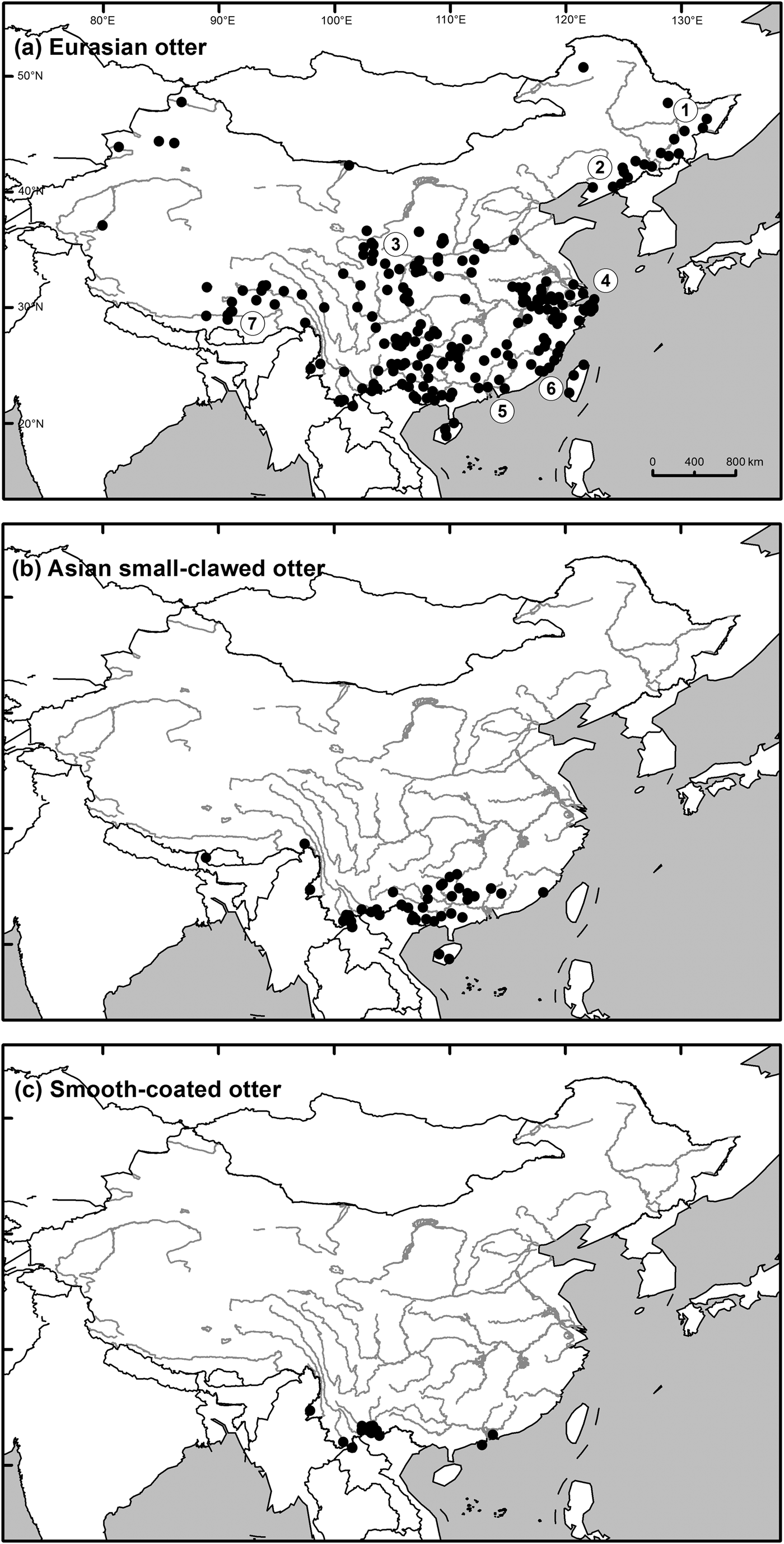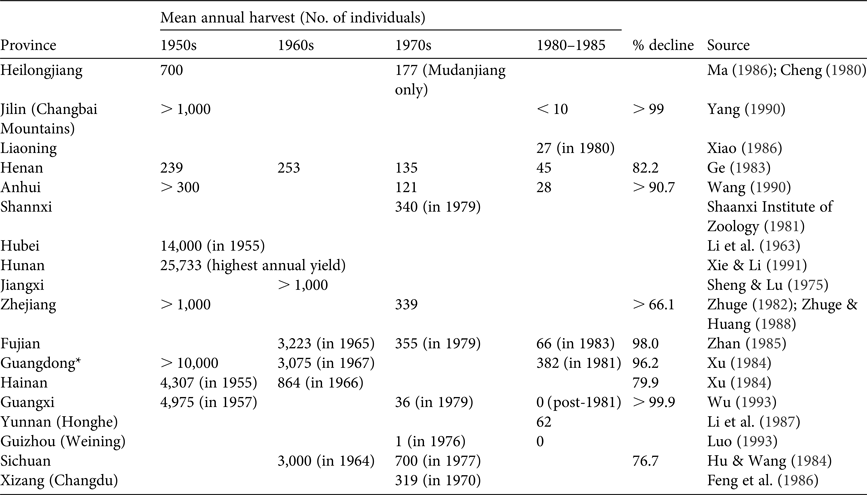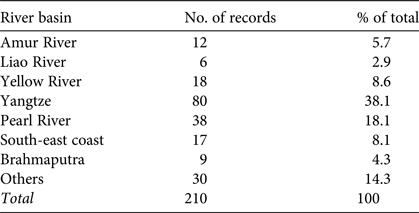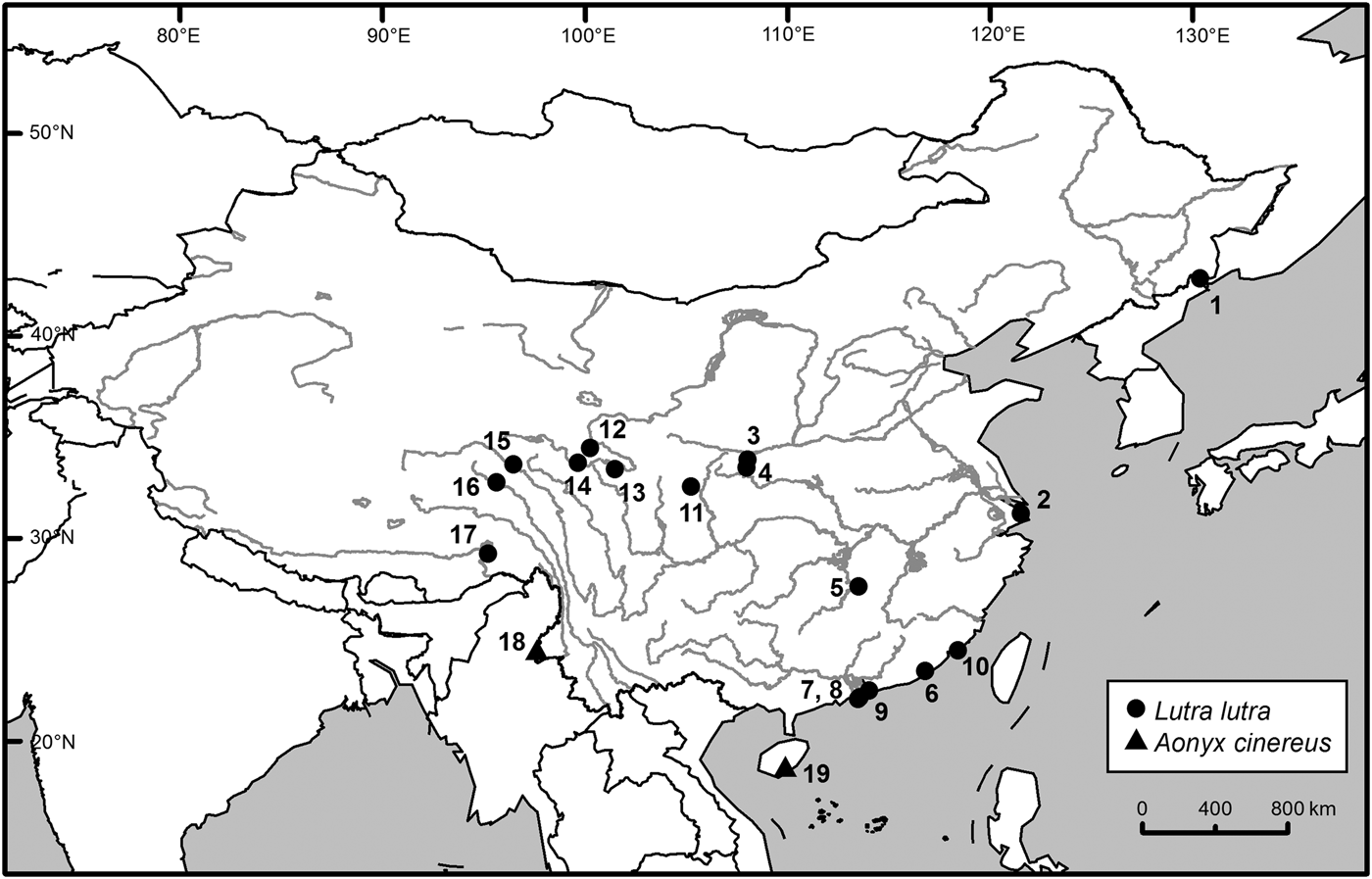Introduction
Otters are top predators in many freshwater ecosystems and serve as indicators of healthy aquatic environments (Kruuk, Reference Kruuk2006). In Europe and the Americas they are fairly common research subjects, and flagships for freshwater conservation (Mason & Macdonald, Reference Mason and Macdonald1986; González & Utrera, Reference González and Utrera2004; Recharte Uscamaita & Bodmer, Reference Recharte Uscamaita and Bodmer2010; Stevens et al., Reference Stevens, Organ and Serfass2011; Chanin, Reference Chanin2013; Balestrieri et al., Reference Balestrieri, Messina, Pella, Prigioni, Saino and Fasola2016). Although Asian otters are in general decline, otters remain relatively widespread and locally common in the Indian Subcontinent and South-east Asia (Raha & Hussain, Reference Raha and Hussain2016; Willcox et al., Reference Willcox, Visal and Mahood2016). In East Asia, however, the Eurasian otter Lutra lutra is extinct in Japan (Ando, Reference Ando2008; Hance, Reference Hance2012) and has not been recorded on Taiwan Island for over 2 decades (Lee, Reference Lee2015); and the Asian small-clawed otter Aonyx cinereus is either extirpated or extremely rare throughout much of its range in China (Wright et al., Reference Wright, de Silva, Chan and Reza Lubis2015).
Three species of otters are known from China: the Eurasian otter, the Asian small-clawed otter and the smooth-coated otter Lutrogale perspicillata (Gao, Reference Gao1987; Zhang, Reference Zhang1997a; Wang, Reference Wang2003; Smith & Xie, Reference Smith and Xie2009). Historically, otters in China were hunted for fur and medicine, and eradicated as an aquaculture pest (Cui, Reference Cui1959; Ni, Reference Ni1986; Sun, Reference Sun1991; Liu, Reference Liu2013). All studies in recent years have reported a marked decline in otter populations throughout China (Lau et al., Reference Lau, Fellowes and Chan2010; Zhang et al., Reference Zhang, Yoxon and Yoxon2014; Chen et al., Reference Chen, Yu, Chen, Shen, Li and Ma2016; He et al., Reference He, Sun, Chen, Dong, Wang, Wang and Li2016), and all three species are categorized as Endangered on the National Red List (Jiang et al., Reference Jiang, Jiang, Wang, Zhang, Zhang and Li2016).
Here we provide a comprehensive overview of the status and distribution of otters in China, based on a literature review, interviews and field surveys, to provide the basis for developing an appropriate conservation strategy for this group of carnivores.
Methods
Past status and distribution (1950–2005)
Distribution data were collated from scientific and grey literature (e.g. Hu & Wang, Reference Hu and Wang1984; Feng et al., Reference Feng, Cai and Zheng1986; Gao, Reference Gao1987; Zhang, Reference Zhang1997a; Huang et al., Reference Huang, Cui, Li, Li and Jiang2017). We also checked catalogued otter specimens deposited in the following institutions, for unpublished records: Guangdong Institute of Applied Biological Resources (n = 6), Kunming Institute of Zoology (n = 11) and Beijing Institute of Zoology (n = 5) of the Chinese Academy of Sciences.
We searched government-published wildlife trade records from the 1950s to 1985 for data on otters. During this period wildlife products were considered to be a major source of revenue (State Forestry Administration of the People's Republic of China, 1959; Chen, Reference Chen1964), the trade was centralized and hunters’ kills could be sold only to the nearest state-owned forest product bureau and medicine companies (Yang et al., Reference Yang, Meng, Xia and Feng2003). As international, and even inter-provincial, trade of pelts was negligible during the period, we assume that government trade statistics accurately reflect changes in the abundance and distribution of game animals over time (Ma & Jia, Reference Ma and Jia1990). The situation changed after 1985 with China's open-door economic policy, and official trade statistics are no longer a reliable indicator of the status of wild species (Zhang, Reference Zhang1997b).
Present status and distribution (2006–2016)
We consulted 32 species or area experts throughout China to obtain recent information on otters, and compiled all recent records of otters (2006–August 2016) located in scientific publications, grey literature and social media platforms. For grey literature and social media posts, only those supported by photographic evidence were treated as positive records.
We conducted otter surveys during 2012–August 2016, using interviews with local people, transects and camera-trapping (Kruuk et al., Reference Kruuk, Kanchanasaka, O'Sullivan and Wanghongsa1993; Kruuk, Reference Kruuk2006; Delibes et al., Reference Delibes, Calzada, Clavero, Fernández, Gutiérrez-Expósito, Revilla and Román2012; Willcox et al., Reference Willcox, Visal and Mahood2016). We walked transects of up to 1,000 m in length along watercourses and lotic habitats at 15 sites: two were in the Irrawaddy Basin, three in the Pearl River Basin, nine on Hainan Island and one in the Huaihe River Basin. During the transect surveys we searched for otter signs such as spraints, footprints, latrine and den sites, and food remains. Camera-trapping was conducted at seven sites for which local interviewees reported recent sightings of otters: two in the Irrawaddy Basin, one in the Pearl River Basin and four on Hainan Island. Camera traps (Loreda L510, Loreda, Shenzhen, China; Ltl Acorn 6210, AcornCamera, Shenzhen, China; SG-990 V, Shenzhen Siyuan Digital Technology Co., Shenzhen, China) were set up in front of latrine sites and otter dens, with a total effort of 2,330 trap nights. Commercial bait (Hawbaker's Otter Lure, Fort Loudon, USA) was applied to 24 of the 39 camera-trap stations. Coordinates of surveyed sites and otter records were recorded using a global positioning system. To avoid sampling bias, all surveys were carried out by the same core survey team.
Results
Past status and distribution (1950–2005)
According to provincial pelt trade statistics for 1953–1985, otters were abundant in many provinces, particularly in the Yangtze and Pearl River Basins, and > 10,000 individuals were killed annually in each of these basins before the 1960s. In 1957 alone, > 40,000 pelts were officially traded in China (Wu, Reference Wu1993). However, by 1980–1985 the annual harvest of otter pelts had decreased dramatically (Table 1). The Eurasian otter was the most widespread otter species in China, with records from all major basins, including Hainan and Taiwan Islands (Fig. 1a); the majority of records were from the Yangtze and Pearl River Basins (Table 2). The Asian small-clawed otter was restricted to the tropical and subtropical regions of the country. Historical records were from the Brahmaputra, the Irrawaddy, the Mekong, the Red River and the Pearl River Basins, as well as Hainan Island (Fig. 1b). The species has been reported from south-western Sichuan Province in the Yangtze Basin (Hu & Wang, Reference Hu and Wang1984), as well as Kinmen Island of Taiwan, close to the Fujian coast (Allen, Reference Allen1938; Lee, Reference Lee1996), but these records are outside the species’ known range and are not supported by unequivocal evidence, and thus we consider them erroneous. The smooth-coated otter occurred only in the Pearl River Delta of Guangdong Province and the international borders of the Red River and the Irrawaddy in Yunnan Province (Fig. 1c). The records from Guangdong Province represent a disjunct distribution at the easternmost limit of the species’ continental range. An adult male was collected from Taishan County, Guangdong, and its tail length was substantially shorter than those of specimens from Yunnan (Xu et al., Reference Xu, Wu, Yu and Wang1989; Liu, Reference Liu1992, cited in Zhang, Reference Zhang1997a).

Fig. 1 Historical distribution (1950–2005) of (a) the Eurasian otter Lutra lutra, (b) the Asian small-clawed otter Aonyx cinereus, and (c) the smooth-coated otter Lutrogale perspicillata in China. Major river basins are numbered as follows: 1, Amur River; 2, Liao River; 3, Yellow River; 4, Yangtze; 5, Pearl River; 6, South-east coast; 7, Brahmaputra.
Table 1 Data on the trade in pelts of the Eurasian otter Lutra lutra in China during 1950–1985 (in some southern provinces pelts may include those of smooth-coated Lutrogale perspicillata and Asian small-clawed otters Aonyx cinereus).

* Hainan Island was part of Guangdong Province until 1988, and therefore these data include otters harvested from Hainan Island.
Table 2 Historical distribution (1950–2005) of the Eurasian otter in major river basins of China (Fig. 1).

Present status and distribution (2006–2016)
Our surveys confirmed the presence of otters at three sites in southern China, and nine of the 32 wildlife experts consulted had recent information on otters. Altogether, we confirmed 19 sites in 10 river basins with recent records of otters during 2006–August 2016 (Table 3; Fig 2); more than one-third of these sites are outside China's official protected area system. The Eurasian otter was recorded at 17 sites, and the Asian small-clawed otter was recorded at two sites. We could find no recent record of the smooth-coated otter in China.

Fig. 2 Locations in China where otters were recorded during 2006–August 2016. See Table 3 for site details.
Table 3 Records of otters in China during 2006–August 2016 (Fig. 2), with site, river basin/drainage system, status/inferred status, and type of record.

The current pattern of otter distribution in China can be divided into three broad categories: (1) otters in well-protected nature reserves, whose survival there may be a by-product of intensive efforts to protect other flagship species, such as the Siberian tiger Panthera tigris altaica at site 1, the giant panda Ailuropoda melanoleuca at sites 3, 4 and 11, and rare waterbirds at site 9 (Table 3; Fig. 2); (2) otters in sparsely populated remote areas (sites 12–16 are located at the headwaters of the Qinghai–Tibetan Plateau, where local spiritual beliefs prevent excessive hunting; sites 17–18 are along remote international borders, with low human population density); (3) otters in suburbs with plentiful freshwater, where they can survive provided that extensive coastal and freshwater habitats are available (sites 2, 5–10).
Discussion
Otters were once widespread and common in China, but sustained, large-scale commercial hunting had wiped out many populations by 1980. Various reports indicate a 90% decline in harvest (Liu & Yuan, Reference Liu and Yuan1981; Li et al., Reference Li, Wu, He and Dai1982; Luo & Zhang, Reference Luo and Zhang1988; Xiao, Reference Xiao1988; Huang, Reference Huang1989; Xu et al., Reference Xu, Wu, Yu and Wang1989; Ruan & Gong, Reference Ruan and Gong1999; Zhang et al., Reference Zhang, Yang, He, Dai., Peng and Lu1999) and, in some areas, local extinctions (Luo, Reference Luo1993; Zhu, Reference Zhu2006). Although all otter species native to China are legally protected, by the time commercial harvesting was curbed, in 1989, the damage had already been done and otter numbers were at a historical low.
Research on and conservation of otters in China have been minimal. We located only 10 scientific articles on the conservation and/or ecology of Chinese otters published after the 1990s (e.g. Piao et al., Reference Piao, Sui, Wang, Li and Zhu2011; Chen et al., Reference Chen, Yu, Chen, Shen, Li and Ma2016; He et al., Reference He, Sun, Chen, Dong, Wang, Wang and Li2016; Zhang et al., Reference Zhang, Yang, Laguardia, Jiang, Huang and Lv2016). Apart from the Eurasian otters on Taiwan's Kinmen Island (Lee, Reference Lee1996, Reference Lee2013, Reference Lee2014, Reference Lee2015) and in Hong Kong (Yoxon & De Silva, Reference Yoxon and De Silva2017), little has been done to protect the dwindling populations. Although it is possible other relict populations persist in remote parts of China, the low number of confirmed records for 2006–2016 suggests that all three otter species are on the verge of extinction in China.
Otters are resilient to highly modified anthropogenic landscapes (Melisch et al., Reference Melisch, Young and Sadovy1998; Shek, Reference Shek2006; Lee, Reference Lee2015; Theng & Sivasothi, Reference Theng and Sivasothi2016), flexible in habitat selection (Aadrean et al., Reference Aadrean, Salmah, Salsabila and Rizaldi2010; Meijaard, Reference Meijaard2014; Weinberger et al., Reference Weinberger, Muff, de Jongh, Kranz and Bontadina2016), and can recover from low numbers (Kruuk, Reference Kruuk2006; Romanowski, Reference Romanowski2006; Marcelli & Fusillo, Reference Marcelli and Fusillo2009; Recharte Uscamaita & Bodmer, Reference Recharte Uscamaita and Bodmer2010). Thus, the Chinese Government, together with scientists, NGOs and the general public, can still save China's otters from extinction if effective conservation interventions can be implemented. We recommend three actions:
National otter survey There has never been a coordinated national survey of otters in China. According to Chinese law, the management of most protected areas is under the jurisdiction of the State Forestry Administration, whereas protection of otters is the responsibility of the Ministry of Agriculture, which manages all aquatic wildlife. This separation of responsibilities can be counter-productive. It is imperative that the government remove this administrative obstacle and organize a national otter survey, so that significant populations and priority sites can be identified.
Conservation measures at priority sites We urge local and international research institutes and NGOs to collaborate with government authorities to implement conservation actions at priority sites. The best opportunity is probably to safeguard a few source populations of each species in protected areas, for future recolonization of unoccupied habitats (Romanowski, Reference Romanowski2006; Delibes et al., Reference Delibes, Calzada, Clavero, Fernández, Gutiérrez-Expósito, Revilla and Román2012; Weinberger et al., Reference Weinberger, Muff, de Jongh, Kranz and Bontadina2016). Conservation of the Guangdong population of Eurasian otters (and possibly the smooth-coated otter, if still present) lies in the effective management of aquatic ecosystems in the Pearl River Delta, including the mangrove-lined bays, waterways, marshes and fish ponds of Mai Po–Inner Deep Bay Ramsar Site of Hong Kong, Macau, the Neilingding Island–Futian National Nature Reserve and Zhuhai City. If properly managed, this landscape could provide a sanctuary for otters amidst megacities, as in the case of Singapore's smooth-coated otters (Theng & Sivasothi, Reference Theng and Sivasothi2016) and Java's Asian small-clawed otters (Meijaard, Reference Meijaard2014).
Scientific study of Chinese otters Knowledge of the ecology and phylogeny of various populations is important to identify evolutionarily significant units for informed conservation actions (Crandall et al., Reference Crandall, Bininda-Emonds, Mace and Wayne2000). There are major gaps in our understanding of otter taxonomy and ecology in China (Jia et al., Reference Jia, Wu, Zhang, Liu and Yang2002; Lei & Li, Reference Lei and Li2008; Piao et al., Reference Piao, Sui, Wang, Li and Zhu2011). Chinese mammalogists currently recognize five subspecies of Eurasian otter native to China, namely L. lutra lutra, L. lutra chinensis, L. lutra nair, L. lutra kutab and L. lutra hainana (Wang, Reference Wang2003). This classification is subject to debate and the exact distribution boundaries between subspecies are unclear. A comparative study, combining molecular and morphometric work, of Eurasian otters across China and from neighbouring countries is required. The disjunct population of smooth-coated otters in the Pearl River Delta also merits study of its status, distribution and taxonomy.
Acknowledgements
We are indebted to Brian I.T. Iu, Cui Shiming, Feng Li-min, Fan Pengfei, He Bing, Liu Yang, Li Cheng, Li Sheng, Ma Ming, Wong Kai Chin, Wang Ruiqing, Wu Jiawei, Zhu Lei, and Shan Shui Conservation Center for providing updated information on otters. We thank Guangdong Institute of Applied Biological Resources, Kunming Institute of Zoology and Beijing Institute of Zoology for permission to study otter specimens in their collections. Permission and logistics support for fieldwork were provided by Hainan Provincial Forestry Department, Guangxi Provincial Forestry Department, Yunnan Yingjiang Forestry Bureau, and Anhui Tianma National Nature Reserve. We thank our colleague Xi Zheng for map preparation.
Author contributions
Both authors contributed equally to data collection during surveys and interviews, the literature review, and the writing of the article.
Biographical sketches
Fei Li’s research focuses on avian and mammal conservation in China. Bosco Pui Lok Chan works on the conservation of threatened species and habitats in China, particularly in the tropical regions.







